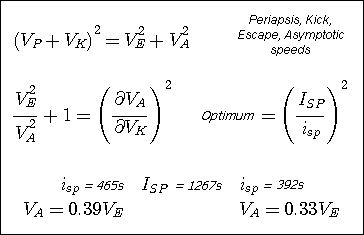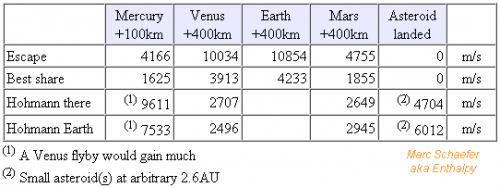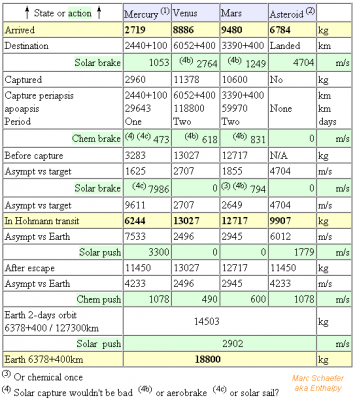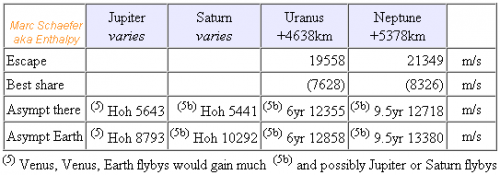-
Posts
3887 -
Joined
-
Last visited
-
Days Won
1
Content Type
Profiles
Forums
Events
Everything posted by Enthalpy
-
A strong pressure wave goes faster than sound, whose velocity is computed by assuming a small pressure variation. Shock waves made by explosions in air travel faster than sound. So experimentally, the phase change demands a strong pressure variation, but this alone may create a faster wave, making the interpretation more difficult. If a stronger is to pressure freeze the liquid, the liquid must contract upon freezing - what most materials do, water being abnormal. I expect this behaviour to slow down the wave, as it makes the material less stiff: a pressure variation would make a stronger volume variation due to freezing. As reversible freezing means much heat, pressure would probably freeze only a part of the material, but this changes only the figures, not the concept.
-

"how to calculate Planck const at home"
Enthalpy replied to Iwonderaboutthings's topic in Quantum Theory
Here's a datasheet for a series of LED diodes http://www.tme.eu/de/Document/c20126608a1d3a620ecfe31f04c5b3c7/L-1002YD.pdf - Some are just GaP, others have a GaAsP heterojunction on GaP (p. 1) - The typical direct voltage varies between 2.0V (for red) and 2.25V (red as well) passing by 2.1V (yellow) and 2.2V (green) (p. 2) - The center wavelength varies from 700nm to 565nm (p. 3) The lower voltage corresponds to the heterojunction: yellow and high-eficiency red. The homojunction red and green take a higher voltage. Especially, bright red (700nm) requires a higher voltage (2.25V) than yellow (590nm and 2.1V), because this relates to the bandgaps and junction, but not directly with the emitted wavelength. What is not in Wiki's diagram about Leds is that they often use deep dopant levels to make the light, GaP especially so. Then the wavelength doesn't relate simply with the bandgap. Heterojunctions are one other complication and are common. What is in Wiki's diagram is that the direct voltage of a diode is smaller than the material's bandgap. Let's take the bright red example: 2.25V direct voltage, but 700nm make only 1.77eV photon energy because of deep dopant. Or take this green Led based on gallium nitride: http://datasheet.octopart.com/IF-E93-Industrial-Fiberoptics-datasheet-63924.pdf - Typical forward voltage 3.5V - 520nm are 2.4eV photon energy, because a deep dopant makes the green light. -

Angular velocity & impossible situation of relativity
Enthalpy replied to radicalsymmetry's topic in Speculations
I like that one. -

"how to calculate Planck const at home"
Enthalpy replied to Iwonderaboutthings's topic in Quantum Theory
Sensei, you've derailed. I used Leds possibly before you were born. I started playing with electronics at 10. My first profession was engineer for semiconductors, including III-V compounds and optoelectronics - so yes, I've already done such calculations, and more than once. Read a bit and learn that GaP makes red, orange, yellow and green diodes, all with the same direct voltage. Or better, experiment it: I did, obviously you didn't. GaP alone disproves any fixed relationship between the direct voltage and the wavelength. 9 months ago you still believed that energy was quantized in multiples of h, here on this forum. Come on! Go on learning, try to separate very accurately what you know from what you suppose, and don't replace knowledge by loud claims.- 40 replies
-
-1
-
"Actor" is already misleading. There are only observers. If one observer sees "vertical", he knows the other will also, but he can't force the polarization. This has no influence at the other particle. It doesn't need many experiments. The production of entangled particles can be inefficient, but the common behaviour of entangled particles is strong.
-
I suggested there how to share the job among a chemical engine that lets a craft escape a planet and solar ones that accelerates it further http://www.scienceforums.net/topic/76627-solar-thermal-rocket/page-2#entry807522 This improves further if the efficient solar engines first raise the apoapsis and the strong chemical engine uses the Oberth effect to escape only - or when arriving at a planet, capture chemically to an eccentric orbit, then circularize by the solar engines. This is an optimum without inert masses, for this more general elliptic orbit: At Earth for instance: an Atlas V 505, an H-IIB or an Ariane 5 can put 18.8t on a 400km orbit (Ariane 5 Me can more... Wider fairing please!). 15 D=4.572m solar engines bring 14503kg to a 2-day orbit with 127300km apogee; this takes 9 months, good for a space probe. An RL-10 kicks 11450kg to asymptotic 4233m/s - or a lighter and more efficient 15kN engine possibly with electric pumps, more careful with the payload, usable at the destination as well. For 2902m/s performance to the elliptic orbit, the solar engines (at 90% isp because of long pushes) bring 1.46* more mass than an RL-10; the advantage increases because the inert mass of a two-stage launcher penalizes an escape mission; and the combined scheme also saves mass at the destination. ---------- At telluric bodies, probes shall usually land or go to low orbit, and sunlight suffices for the engines. In some cases, the chemical kick gives the whole transfer speed. We can send these masses by the improved scheme - now we're getting somewhere. ---------- At Jupiter and Saturn, the final orbit depends on the mission, which must give time to the solar engines. I decribed there a mission to all of Jupiter's equatorial moons http://www.scienceforums.net/topic/76627-solar-thermal-rocket/#entry756421 instead of multiplying all masses by 0.78 following the wrong estimation of the launcher's capability, 7932kg in transfer permit to multiply them by 2.05, so the mission ends at Io with 800kg instead of 304kg. The mission to all of Saturn's equatorial moons, launched by an Atlas V 505 instead of Delta Heavy, http://www.scienceforums.net/topic/76627-solar-thermal-rocket/page-2#entry773439 ends at the A ring with 980kg instead of 689kg. The transfers need such speeds if no flyby helps - optimum to Jupiter and Saturn, accelerated to Uranus and Neptune: The improved scheme sends these masses - in transit for Jupiter and Saturn because the missions vary too much from there on: If a mission needs short pushes there, a hydrogen resistojet and a battery may perform better than direct heating by sunlight. ---------- At Uranus and Neptune, the solar engines would take too long. Chemical engines impose then eccentric orbits. The masses in the table are for twin missions in direct transfers, more accelerated to Uranus, similar to http://www.scienceforums.net/topic/76627-solar-thermal-rocket/page-2#entry757109 http://www.scienceforums.net/topic/76627-solar-thermal-rocket/page-2#entry757109 (multiply all masses there by 0.78: then 600kg in orbit, the new scheme improves to 2000kg) The probe arrives at the point that puts its apside line in the planet's equatorial plane and brakes near the planet. This may put the periapsis in daylight or not. In a first phase, the probe observes the planet from there and looks for new moons. Then the inclination and the apoapsis are reduced in small steps to overfly the irregular non-equatorial moons as possible. When in equatorial orbit, the probe observes the lower moons. Marc Schaefer, aka Enthalpy
-

How can different types of plastic be cheaply and easily identified?
Enthalpy replied to Johnish's topic in Organic Chemistry
The real limit is not the price of a photodiode, but rather the time it takes to identify every piece of garbage. Density is excellent in a workshop where you have nice cylinders to measure. In garbage, the shapes are too complicated, and also use to trap air bubbles in flotation processes, whose sorting is gross. Same for the flame aspect and odour I like to use. It's accurate, but impractical to sort several pieces a second. In a real situation, one needs really fast methods. Nuclear apparatus that identifies the elemental composition might possibly be made swift enough, but it's expensive. I'd consider firing a pulsed laser on each garbage piece and analyze the fume's optical spectrum. This would also sort out metals and ceramics. Though, there are strong limits to any sorting. For instance, polyamides (polyolefines as well) have extremely varied properties and must be sorted accordingly, but chemically they're nearly the same. The you have all the charges: if Petp contains chopped glass fibers it shouldn't be mixed with pure one. Few per-cent plasticizer change Pva's behaviour radically. Plastics are often blended. They're sometimes painted. Each object may consist of several plastics and is generally hollow, so garbage is generally crushed first to get homogenous compact chips, but these are so many! In the best cases presently, polyolefines and polyesters are separated from the rest, but not with more detail. As a result, recycled plastic is of little interest, but not much cheaper than new one; it provides felt mainly. Some blankets and clothes are made of this felt. -
The (fuzzy) dimensions of an orbital decreases with more protons as these attract the electrons more strongly. The realtion is inversely proportional. This tells why the ionization energy of the K shell increases as the square of the number of protons. The angular momentum of an orbital may be definite, at least around one direction. The speed is a less clear idea; by most definitions of speed, it's zero for all spherical shells.
-

"how to calculate Planck const at home"
Enthalpy replied to Iwonderaboutthings's topic in Quantum Theory
And if you had made the computation, you would have seen that it doesn't fit. The direct voltage is not the bandgap. Also, by choosing the dopant, GaP with the same direct voltage produces red, orange, yellow or green light. There is some link between voltage and wavelength, but too inaccurate to get the first mantissa position of Planck's constant. -
"If someone observes" is already a risky step. "If the state of one particle is known" seems a more careful formulation, because action (like detection) at one particle won't affect the other. Say, the detector is sensitive to vertical polarization only: it won't force the photon to be vertical. It may force the photon (hence pair) to decide whether it is vertical (then detected) or horizontal (then undetected), and the other photon then has the same polarization, so two detectors would give correlated results. Well... At least one experiment by a known researcher claims to see the absorption of one photon influence the other, but over the two arguments he gives against a different effect at his non-linear crystal, one (amplitude) is weak to my eyes, and the other argument (linear amplitude instead of quadratic) may well result from the crystal's behaviour, which is less than simple. I haven't heard of a confirmation by an other group neither. So presently people live with ideas like: both particles decide their state late and in a correlated way, faster than light, but action at one particle doesn't influence the other, so no instantly data transfer is possible. Also good to know: the entanglement quality is limited by the uncertainty relations. Say, if photons come from a small generator, their directions may be linked, but within an accuracy limited by the source's dimensions - the diffraction limit - as per the position versus momentum uncertainty.
-
And some chemistry obviously, I forgot it. Necessary for any person, even more so for an engineer. Not necessarily everything about synthesis, analysis methods and the rest - but a working intuition about the risks of inorganic compounds, the compatibility with materials, the stability at heat, risks for the environment, all this general knowledge. Just an example: Solar thermal plants store heat in molten nitrates; you must know in a titanium container is acceptable, or if the spillage of lubricating oil is a worry. The biggest hurdle for energy efficiency and for renewables is the cost, because fossile fuels are so cheap. Some sort of capability to estimate costs would be necessary; I don't know how to acquire it.
-
Hi Energypassion97, welcome here! "Best path to take to guarantee a good job": does that exist? Probably not. Engineering evolves quickly - software and electronics more so than mechanical engineering, but all do - and what looks in demand today won't be in 20 years. World trade evolves quickly as well, and development and production made in Europe 20 years ago is now imported from China. I got my engineering diploma 30 years ago, and no single comrade works in the topic he specialized in then. I suggest that you pick as broad knowledge as possible - in engineering AND sciences AND languages and also maths, possibly economy and management if compatible with your tastes. Energy efficiency and renewables need very varied knowledge anyway, so you need a broad education. In addition to the environmental, energy, and electrical you mentioned, you need for sure: materials, production methods, mechanical design, thermal design. Very interesting as well to my taste, and they should belong to every engineer's programme as much as maths do. Biology is an obvious future, including for energy, and must probably belong to the background of general engineering. Hope you like it more than I do.
-

Engineering of carbon allotropes in the lab
Enthalpy replied to petrushka.googol's topic in Applied Chemistry
Yes, graphite, fullerenes, nanotubes and commonly produced in labs, and in smaller quantities by fires. Coal is a hydrocarbon mainly, not carbon. -
How do you produce the entangled photons with a simple and cheap setup? This was a long debate among the best scientists. Presently the near-consensus is that particles are random by nature, as opposed to cards in envelopes, which are fully determined but are not observable with some available methods, and could become observable once the adequate X-rays are invented - that was the "hidden variable" interpretation. To my understanding, a single particle gives no answer between both interpretations. But entangled particles do tell "random", unless one seeks very bizarre alternative interpretations. The deep reason with photon polarization is that we can observe the same source of pairs with linear or with circular detectors, as detailed there: http://www.scienceforums.net/topic/83752-probabilities/#entry811449 and if the photon pair (or their source) decided upon emission which linear polarization the choose, there would be no correlation between the circular detectors - but correlation is observed. Same against a circular polarization chosen at emission: linear detectors show a correlation. So the (very broad) mainstream interpretation is that the polarization is not determined upon emission but upon detection, and for entangled particles, that both "decide" the same way. More disturbing, and again decided by experiment: both particles correlate within a time shorter than light would take to propagate between the detectors. Though, entangled particles are not so different from a single one in that aspect. A photon can be meters or light-years broad (or "its wave" is broad, for some people here) but if it's detected at one place, it gets immediately unavailable for the other detectors, including the remote ones. Entangled particles only differ in that they hamper the "hidden variable" interpretation, in this case the direction of the photon decided at emission.
-

To make new music instruments for to learn acoustics?
Enthalpy replied to science4ever's topic in Amateur Science
No, the intonation is catastrophic. -
O yes, apologies. You mean Moon's L1, L2, L3, don't you? I was wrongly thinking at Earth's L1 which made less sense. Moon's Lagrange points are indeed better than orbits, agreed. ---------- Frankly, you shouldn't worry about storing cryogenic propellants indefinitely in space. This is easy technology, everyone needs it, so you will have it. A consumer fridge works for years, so with more bucks and redundancy, the cryocooler can be reliable - more so anyway than the software that orients the sails and regulates the vessel's temperature. And even if storing water, electrolysis will take months so the cold propellants must be stored. Worse: the tanks must be superinsulated anyway, or the heat leak is so big that electrolysis can't replenish them fast enough. It's easier to cool the propellants than replenish them by electrolysis. Let's take as an example 100t of 6:1 O2:H2, that's 200m3 of H2, or a sphere of D=7.3m S=166m2 exposed to 300K. - Alone liquefying the produced hydrogen is worse than keeping liquid the available hydrogen. - 2t foam (heavy!) leak 7kW which would evaporate 7mol/s. That's the whole 14t H2 in 12 days, so obviously foam is impossible. - So hold the tank by polymer belts and have 25 layers of film insulation (150kg). At 0.02 emissivity, the stack leaks well under 20W, and so do the belts. 40W at 20K mean a redundant 1kW cryocooler, easy. Now if producing 14t H2 in 3 months, alone liquefying them takes 800W at 20K, or a 20+kW liquefier. Electrolysis takes 500kW. I prefer to leave such hardware on the Moon than bring it near Mercury - even more so because lifting the water from the Moon already needs propellants. ---------- The scenario is still very obscure to me. You've spent much time on it and it's yours so it must be clear for you, but to newcomers it's esoteric. What about, say, a list of the modules, telling where each comes and goes and when? Then you might tell what its propulsion is, which speed increment it needs, how long it takes in the case of a solar sail, and what the masses are at beginning and end.
-

"how to calculate Planck const at home"
Enthalpy replied to Iwonderaboutthings's topic in Quantum Theory
More or less... - The direct voltage of a diode is not the material bandgap that may relate with the wavelength. Silicon has 1.12eV bandgap but a silicon diode direct voltage is rather 0.55V to 0.7V (more if losses are big). - Many Led radiate from dopant levels deep in the bandgap to obtain the desired colour, typically the green and yellow ones made of GaP. Then the photon energy is significantly less than the bandgap. - The direct voltage does not convert in electron kinetic energy. A few microwave components achieve 0.5eV or 1eV electron kinetic energy, so do avalanche components as well. In about all others, the carriers' kinetic energy is small, under the 26meV thermal energy at RT. -
You shouldn't take "point-like" as a definition of "particle". Our real need for particles is that some of their properties can't split: the electron's charge, spin, the photon's energy... so we count these things with integer numbers. When for instance an electron in a semiconductor detector absorbs a photon, the electron is very big (many thousand atoms volume) before, very big after, and the photon was generally very big, say the size of a pixel. Telling more accurately where (for instance, at which atom) the absorption occured would be provably wrong. Whether particles are permanently points whose position is probabilistic (hi Swansont and the majority of scientists) or are the wave itself (my opinion presently, with good companions like Schrieffer) make little concrete difference. I feel a wave and nothing more is easier to figure, but maybe I get in trouble in the future. What's certain and is agreed on: particles can concentrate and keep their fixed attributes like the charge, unsplit and available once. "Fundamental" particles like the electron can concentrate as much as our experiments permit to check, while composite particles like the proton show subcomponents if the experiment detail them enough. This ability to expand or concentrate (or at least their waveform) is common to all particles, so you shouldn't distinguish between electrons and photons here. A 0.5µm wavelength photon coming from a star can be light-years wide; the telescope concentrates it to a pixel 5µm wide; it's absorbed by one electron 10nm wide, or if strayed, can again be meters wide. Exactly the same way, electrons can be large in a metal or a big molecule, but an electron beam can tell much more precisely where an interaction with them happened; the target electron "decides" then (and no earlier) if it interacts hence where it is. Size and shape are just some variable attributes of particles among many. Other attributes like the momentum, the angular momentum... are uncertain (more or less uncertain depending on the particle's state) which evolve according to the subsequent interactions; sometimes these interactions are measurements, which try to determine accurately one of the particle's attributes (be it the position or an other) and then the particle's state becomes simpler for that attribute - other attributes become more uncertain as a consequence. For instance, if a measurement forces a particle to decide an accurate position, the momentum gets uncertain as a consequence.
-

Solar experiment that gets 7KW per square meter of sunlight??
Enthalpy replied to SolarGraphene's topic in Experiments
Did you? -
Inventors spend their whole life searching for that, rarely finding - and this should be a school project?
-

To make new music instruments for to learn acoustics?
Enthalpy replied to science4ever's topic in Amateur Science
Thanks for the links! A good player obviously. Nevertheless, the intonation is poor, among other shortcomings of the instrument. Then, the sound of a wooden horn can't be replaced, sure. -
Hall effect sensors are dirt-cheap, just buy: http://www.conrad-electronic.co.uk/ce/en/overview/0231410/Magnetic-Field-Detectors-Hall-Sensors I've seen some meant for use with a multimeter: properly calibrated and with the convenient connectors.
-
It is done. Not in Yellowstone nor at the Etna, but in the Rhine valley, thousands of kilometers to the next geyser. Nuclear power plants are presently the most expensive option by far. Coal is cheap, gas less cheap, and meanwhile wind energy (factoring in that it runs at 25-35% capacity on mean, but not factoring in electricity storage which isn't still done on the proper scale) is cheaper than nuclear one. Electricity transport is solved, wake up. Brazil did it 30 years ago from Itaipú to São Paulo for 13GW over 800km. Efficient and affordable. Same in Quebec and many places.
-
Nonsense. http://en.wikipedia.org/wiki/Power_factor
-
Hi Guysbarash, welcome here! This query is difficult. It is equivalent to predicting the length of an error-correcting code given the number of data bits and the number of positions to correct (=half the distance). No general response exists, but heuristic bounds are known which are not bad. A naive strict minimum is rather simple, but rarely attained (by Hamming codes, the Golay code, and I know no other so-called "perfect" code). http://en.wikipedia.org/wiki/Binary_Golay_code Take the length of the code which includes the redundancy, compute all combinations of 0 to D modified positions in this code: their binary log must be smaller than the length of the redundancy - just to contain enough information. Most codes do not attain the minimum length, and even less so if one wishes a method to decode them, which is generally the case. The Bch codes are general, can be long, and are not bad. They add Log2(length including redundancy +1) redundancy bits for every distance bit. http://en.wikipedia.org/wiki/BCH_code Hamming codes are less general than your query, as they guarantee only one corrected bit. http://en.wikipedia.org/wiki/Hamming_code In error-correcting codes, we say "redundancy" rather than "parity", among others because some codes are not binary, for instance the Reed-Solomon ones http://en.wikipedia.org/wiki/Reed-Solomon http://en.wikipedia.org/wiki/Reed-Solomonhttp://en.wikipedia.org/wiki/Reed-Solomonhttp://en.wikipedia.org/wiki/Reed-Solomon






